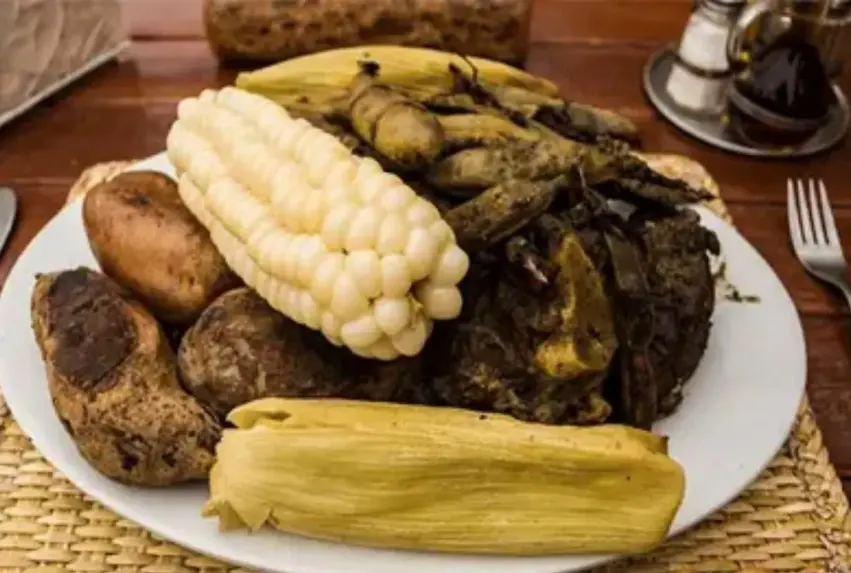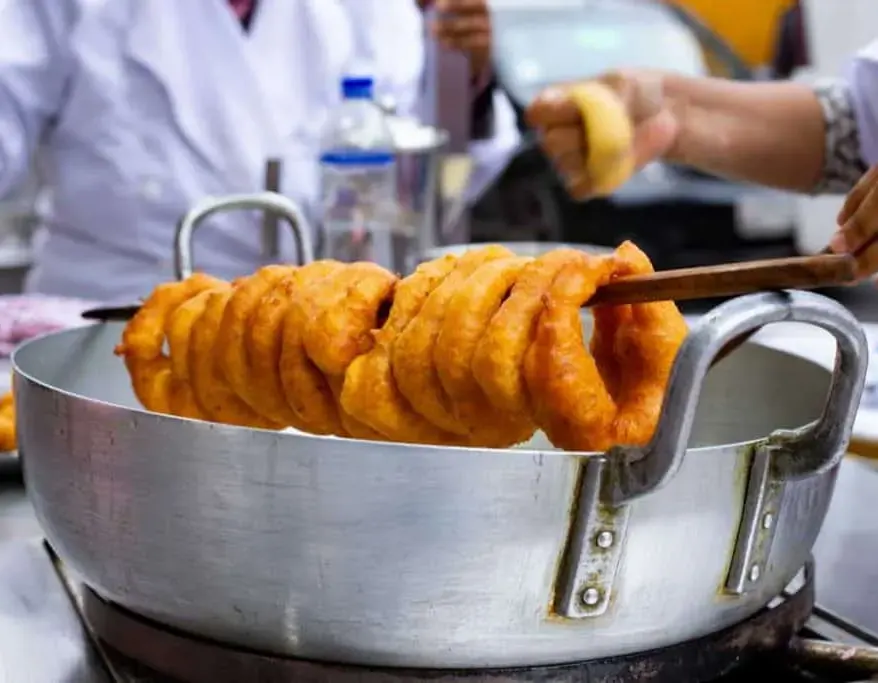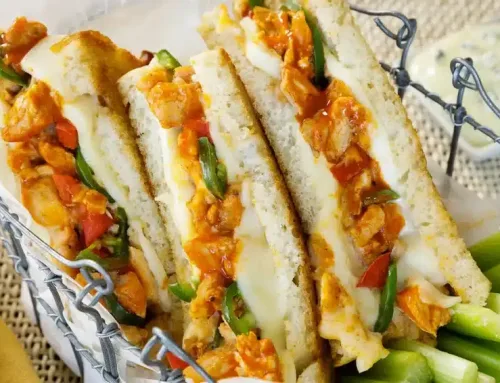Everyone thinks that Peru is about a sweeping mountainous range and diverse culture, but you cannot ignore the rich food options that you can get.
The Peruvian recipes are extremely compelling and make you want to try every recipe out there.
The Peruvian recipes are a collection of spicy, salty, sweet, and mild flavors, so you can enjoy a medley or fusion of flavors.
Our list of recipes has something for each one of you, ranging from appetizers to puddings and stews, so wear the chef hat!
Ceviche de Pescado
Ceviche de Pescado is a quintessential Peruvian dish that showcases the country’s love for fresh seafood.
It’s a refreshing and tangy dish made from raw fish, typically marinated in a mixture of lime juice, onions, cilantro, and aji peppers.
The ceviche is often served with sweet potatoes, corn, and lettuce, creating a harmonious balance of flavors and textures.
Ceviche de Pescado is not just a dish; it’s a cultural experience that captures the essence of Peru’s coastal cuisine.

Lomo Saltado
Lomo Saltado is a flavorful and hearty Peruvian stir-fry that perfectly blends the influences of Chinese and Peruvian cuisines.
This dish features strips of beef (lomo) sautéed with onions, tomatoes, and aji amarillo peppers, and then combined with French fries.
The unique combination of beef, vegetables, and fries is seasoned with soy sauce, vinegar, and spices, creating a savory and slightly tangy flavor profile.
Lomo Saltado represents the fusion of culinary traditions and the vibrant flavors that make Peruvian cuisine so distinctive.

Anticuchos
Anticuchos are a beloved Peruvian street food that showcases the country’s knack for transforming humble ingredients into culinary delights.
These skewered and grilled meat bites are traditionally made from marinated beef heart, although other meats like chicken or beef can be used as well.
The meat is marinated in a mixture of vinegar, aji panca, garlic, cumin, and other spices, imparting a rich and smoky flavor.
Grilled to perfection, anticuchos are often served with boiled potatoes, corn, and a spicy peanut sauce known as “salsa de huacatay.”

Aji de Gallina
The dish has chicken bathed in a creamy sauce made from aji amarillo peppers, milk-soaked bread, walnuts, cheese, and other aromatic spices.
The sauce is velvety and rich, with a balance of mild heat and nutty undertones.
Aji de Gallina is typically served over steamed rice and garnished with hard boiled eggs, olives, and a sprinkle of parsley.
This dish encapsulates the diverse influences that have shaped Peruvian cuisine over the centuries.

Pollo a la Brasa
Pollo a la Brasa, also known as Peruvian-style rotisserie chicken, is a beloved comfort food that has gained international acclaim.
The dish starts with marinating the chicken in a mixture of spices, including cumin, paprika, garlic, and more.
The marinated chicken is then slow-roasted on a rotisserie, resulting in tender, juicy meat with a flavorful and crispy skin.
It’s often served with a side of French fries and a creamy, tangy green sauce known as “aji verde.”

Papa a la Huancaina
This is a popular Peruvian appetizer that celebrates the country’s vibrant flavors and use of indigenous ingredients.
It consists of boiled yellow potatoes served on a bed of lettuce and topped with a creamy and slightly spicy Huancaina sauce.
The sauce is made from aji amarillo peppers, queso fresco, evaporated milk, and crackers, resulting in a velvety texture and a mild kick of heat.
It’s garnished with hard-boiled eggs, olives, and parsley. It’s a harmonious blend of textures and flavors, making it a delightful introduction to Peruvian cuisine.

Rocoto Relleno
Rocoto Relleno is a bold and flavorful dish that showcases the Peruvian love for spicy flavors.
It consists of rocoto peppers (a type of hot pepper) stuffed with a mixture of ground beef, onions, garlic, raisins, olives, hard-boiled eggs, and spices.
The peppers are often topped with melted cheese and baked until golden and bubbly.
Rocoto Relleno reflects Peruvian cuisine’s ability to create dishes that are both fiery and deeply flavorful.

Tacu Tacu
Tacu Tacu is a unique Peruvian dish that creatively repurposes leftovers into a delicious and hearty meal.
It’s made by combining leftover rice and cooked beans, which are mixed and then fried to create a crispy exterior while ensuring tender interior.
This “pancake” is often served with various toppings such as grilled steak, fried eggs, or seafood.
The dish is a testament to Peruvian resourcefulness and culinary innovation, turning basic ingredients into a flavorful and filling plate.

Arroz con Mariscos
Arroz con Mariscos, or “rice with seafood,” is a flavorful rice dish that highlights Peru’s abundant coastal resources.
The dish typically features a medley of seafood such as shrimp, squid, mussels, and fish, all cooked with spices, aji amarillo peppers, onions, tomatoes, and rice.
The result is a colorful and aromatic dish with a combination of textures and flavors from the seafood and the rice.
Arroz con Mariscos is a testament to Peru’s coastal culinary heritage and its ability to create dishes that transport you to the shores of the Pacific.

Seco de Cordero
Seco de Cordero is a hearty and comforting Peruvian stew that celebrates the flavors of lamb and the country’s use of indigenous ingredients.
The dish features tender pieces of lamb slow-cooked with a flavorful mixture of cilantro, aji panca peppers, beer, and spices.
The resulting stew is rich and aromatic, with the earthy notes of cilantro complementing the tender lamb.
Seco de Cordero is served with white rice and creamy canary beans, creating a satisfying and hearty meal that’s perfect for warming up on a cool day.

Chupe de Camarones
Chupe de Camarones is a hearty and flavorful Peruvian shrimp chowder that highlights the country’s coastal bounty.
This dish features shrimp cooked in a creamy and savory broth made from aji amarillo peppers, potatoes, corn, peas, and cheese.
The addition of milk and eggs creates a thick and luscious consistency that’s both comforting and satisfying.
Chupe de Camarones is often garnished with a hard-boiled egg and sprinkled with chopped parsley, making it a true representation of Peru’s culinary diversity.

Causa Limena
Causa Limena is a visually striking Peruvian dish that blends layers of flavors and textures.
It’s made using mashed yellow potatoes mixed with lime, aji amarillo paste, and oil, creating a smooth and vibrant base.
The mashed potatoes are then layered with fillings such as chicken, tuna, or avocado, and sometimes mixed with mayo or huancaina sauce.
The dish is often garnished with olives, hard-boiled eggs, and parsley, resulting in a colorful and visually appealing presentation.

Tiradito
Tiradito is a delicate dish that showcases the country’s expertise in working with raw fish. It’s often compared to ceviche but has its own unique preparation.
Thinly sliced pieces of raw fish are arranged on a plate and marinated in a citrus based sauce that includes lime juice, aji amarillo peppers, and garlic.
The result is a dish with a more delicate texture and a balance of flavors that allows the freshness flavors of the fish.
Tiradito is often garnished with finely chopped herbs and other seasonings, making it a visually appealing and refined dish.

Pachamanca
Pachamanca is a traditional Peruvian dish that pays homage to the country’s indigenous culinary roots.
It involves cooking meats, potatoes, and other ingredients using hot stones buried in the ground, recreating the ancient cooking method.
The meats, such as pork, chicken, and guinea pig, are marinated in spices and herbs, while potatoes, corn, and other vegetables are added for a hearty meal.
The earthy flavors imparted by stones and the aromatic seasonings make Pachamanca a unique dish that connects modern cuisine to ancient traditions.

Humitas
Humitas are a beloved Peruvian dish that showcases the country’s use of corn in various forms.
They are similar to tamales, but instead of using masa dough, humitas are made from a mixture of fresh corn, onion, spices, and cheese.
The mixture is wrapped in corn husks and then steamed or boiled until cooked.
The result is a sweet and savory dish with a tender texture, often enjoyed as a snack or a side dish.

Sopa Criolla
Sopa Criolla is a heartwarming Peruvian soup that embodies comfort and nostalgia.
This dish features a flavorful beef broth enriched with diced beef, spaghetti noodles, milk, and eggs.
The soup is seasoned with spices such as cumin and aji panca peppers, which infuse it with a rich and savory flavor.
Sopa Criolla is often served with a drizzle of lime juice and chopped parsley, providing a burst of freshness that complements the richness of the broth.

Adobo Arequipeno
Adobo Arequipeno is a bold and aromatic Peruvian stew that hails from the city of Arequipa.
This dish features tender chunks of pork marinated in a flavorful mixture of aji panca and aji mirasol peppers, garlic, cumin, and other spices.
The marinated pork is then slow cooked with onions and broth until its tender and infused with the spices.
Adobo Arequipeno is often served with white rice, boiled potatoes, and sometimes a slice of queso fresco.

Olluquito con Charqui
Olluquito con Charqui is a traditional Peruvian dish that celebrates indigenous ingredients and flavors.
Olluco, a root vegetable, is cooked with dried meat known as charqui, resulting in a hearty and satisfying meal.
The dish is often prepared with a flavorful sauce made from aji amarillo peppers, garlic, and spices.
The olluco adds a starchy element, while the charqui provides a chewy and savory contrast.

Carapulcra
Carapulcra is a unique and flavorful Peruvian dish that combines indigenous ingredients with Spanish influences.
It features dried potatoes that are rehydrated and slow cooked with pork, chicken, or beef, resulting in a rich and hearty stew.
The dish is seasoned with a blend of aji panca peppers, garlic, cumin, and other spices, which infuse the meat and potatoes with a deep and complex flavor.
Carapulcra is often served with white rice, and its combination of textures and tastes showcases the culinary diversity of Peru.

Picarones
Picarones are a delightful Peruvian dessert that combines the sweetness of pumpkin and sweet potato with the indulgence of deep frying.
The ingredients are mixed with flour and yeast to create dough that’s shaped into rings and then fried until golden and crispy.
Picarones are served with sweet syrup made from chancaca (unrefined sugar), cinnamon, and cloves, adding a rich and fragrant sweetness to the dish.
The contrast between the crispy yet tender textures, along with the aromatic syrup, makes Picarones a beloved treat that’s enjoyed across Peru.

Chupe de Quinua
Chupe de Quinua is a nutritious and comforting Peruvian soup that features quinoa as its star ingredient.
This hearty soup often includes a variety of vegetables such as potatoes, carrots, corn, and peas, as well as cheese and milk to create a creamy texture.
The quinoa adds a protein rich element and a pleasant nutty flavor to the dish.
Chupe de Quinua is seasoned with aji amarillo peppers, garlic, and other spices, resulting in a flavorful and satisfying bowl of goodness.

Mazamorra Morada
Mazamorra Morada is a colorful and traditional Peruvian dessert that’s both visually appealing and delicious.
It’s made from purple corn, which gives the dish its distinctive hue, and is typically sweetened with pineapple, dried fruits, and spices.
It is cooked until it thickens and is then served either as a porridge like dessert or as a jelly like pudding.
Mazamorra Morada is often paired with a scoop of arroz con leche (rice pudding) or a sprinkle of cinnamon, offering a delightful combination of flavors.

Tallarines Verdes
Tallarines Verdes, which translates to “green noodles,” is a flavorful Peruvian pasta dish that reflects the country’s fusion of Italian and Peruvian cuisines.
The dish features pasta tossed in a creamy sauce made from blended spinach or basil, cheese, garlic, and aji amarillo peppers.
The result is a vibrant green sauce that coats the pasta with a burst of fresh flavors and a hint of heat.
Tallarines Verdes is often served with grilled steak, chicken, or seafood, creating a harmonious blend of cultures and tastes that’s loved by many.

Tamales Peruanos
Tamales Peruanos are a beloved street food and snack in Peru, offering a satisfying and portable treat.
These tamales are made from a mixture of masa (corn dough) that’s seasoned with aji panca peppers, garlic, cumin, and other spices.
The masa is then filled with various ingredients such as chicken, pork, or vegetables, and wrapped in banana leaves before being steamed properly.
They come in different shapes and sizes, showcasing the culinary diversity of the country and providing a flavorful and convenient option for those on the go.

Chicharrón de Pescado
Chicharrón de Pescado is a crispy and flavorful Peruvian dish that celebrates the country’s abundant seafood.
This dish features chunks of fish that are marinated in garlic, lime juice, and cumin, before being coated in flour and deep-fried until golden and crispy.
The result is tender, flavorful fish with a satisfying crunch on the outside.
It’s served with slices of sweet potatoes, red onion, and lime juice, creating a balanced and delightful meal that highlights Peru’s coastal culinary heritage.

Solterito de Queso
Solterito de Queso is a colorful and refreshing Peruvian salad that combines a variety of fresh ingredients to create a delightful and nutritious dish.
This salad typically features boiled corn, lima beans, diced cheese, onions, tomatoes, and olives, all tossed with olive oil, lime juice, and salt.
The result is a harmonious blend of textures and flavors, with the creaminess of the cheese contrasting with the crunchiness of the vegetables.
Solterito de Queso is a light and vibrant salad that captures the essence of Peru’s love for fresh ingredients.

Patasca
Patasca is a hearty and comforting Peruvian soup that’s especially popular in the Andean regions.
The base of the soup consists of beef, potatoes, and hominy (dried corn kernels), creating a rich and substantial broth.
The dish is flavored with garlic, aji panca peppers, and a blend of spices, resulting in a flavorful and aromatic soup.
Patasca is often served with sides of dried corn, fried pork rinds, and fresh herbs.

Frejol Colado
Frejol Colado is a traditional Peruvian dish that celebrates the humble yet versatile black bean.
It’s essentially a bean purée that’s cooked with spices, aji amarillo peppers, and sometimes bacon or pork.
The dish is typically served as a side or accompaniment to other dishes, adding a rich and savory element to the meal.
Frejol Colado is a testament to Peru’s ability to elevate simple ingredients and create dishes that are both comforting and flavorful.

Choros a la Chalaca
Choros a la Chalaca is a flavorful Peruvian seafood dish that highlights the country’s coastal bounty.
It features fresh mussels (choros) served on the half shell and topped with a mixture known as “chalaca.”
Chalaca is made from diced onions, tomatoes, corn, and cilantro, mixed with lime juice and aji amarillo peppers for a burst of freshness and mild heat.
The mixture is spooned over the mussels, creating a vibrant and tangy combination of flavors and textures.

Yuquitas Rellenas
Yuquitas Rellenas are a delicious Peruvian appetizer or snack that features yuca (cassava) dough filled with savory ingredients.
The yuca dough is typically seasoned with aji amarillo peppers and filled with a mixture of ground beef, onions, olives, hard-boiled eggs, and spices.
The filled yuca dough is shaped into small balls or patties and deep-fried to achieve a golden and crispy exterior.
Yuquitas Rellenas are often served with a dipping sauce, such as aji verde or huancaina sauce, adding an extra flavor to this satisfying and handheld treat.

Final Thoughts
Ranging from chicken to steaks and street foods, the Peruvian cuisine is one of the most delicious out there, and there is something for everyone here.
It wouldn’t be wrong to say that Peruvian recipes are suitable for people who don’t mind going on a culinary adventure.
The Peruvian recipes mentioned in this article are pretty beginner friendly, so you won’t have to worry about experimenting with the ingredients.
However, make sure you read up the recipes properly because you want to replicate the authentic flavors.









Leave A Comment